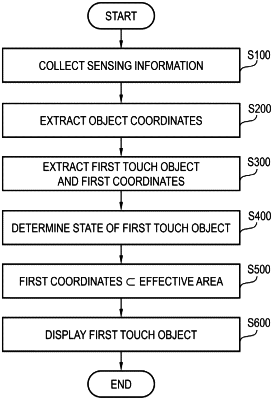| CPC G06F 3/042 (2013.01) | 9 Claims |

|
1. A method for recognizing a touch of an object by a server, the method comprising the steps of:
(a) extracting, on the basis of sensing information about a plurality of objects sensed through a LiDAR sensor, coordinates of the plurality of objects for a plurality of frames including a first frame and a second frame that is a previous frame continuous with the first frame;
(b) performing clustering on coordinates of a plurality of first objects extracted from the first frame to set a first touch object of the first frame and calculate first coordinates of the first touch object, wherein the first touch object corresponds to a first cluster including a number of first objects among the plurality of first objects;
(c) determining a state of the first touch object by using the first touch object and the first coordinates;
(d) converting the first coordinates to real coordinates to determine whether the first coordinates are located in a preset effective area; and
(e) displaying the first touch object at the real coordinates if it is determined that the first touch object is located in the effective area,
wherein the step (c) comprises:
determining whether a second touch object exists in the second frame that is the previous frame continuous with the first frame,
based on the second touch object not existing in the second frame, determining the state of the first touch object as a first enter state, wherein the first enter state indicates that no sensing information is in the second frame and a new touch object is recognized in the first frame,
based on the second touch object existing in the second frame, calculating a second distance between the first coordinates in the first frame and second coordinates of the second touch object in the second frame, and comparing the second distance with a preset second distance threshold value,
based on the second distance being greater than the second distance threshold value, determining the state of the first touch object as a second enter state, wherein the second enter state indicates that the first touch object is located in a different area from the second touch object and a new touch object corresponding to the first touch object is recognized,
based on the first coordinates and the second coordinates being the same with each other, determining the state of the first touch object as a stay state, wherein the stay state indicates that a touch object for which sensing information is present continues to exist on a same area,
based on the first coordinates and the second coordinates not being the same with each other and the second distance being less than the second distance threshold value, determining the state of the first touch object as a move state, wherein the move state indicates that the first touch object has moved from an area on which the second touch object is located to an area on which the first touch object is located.
|